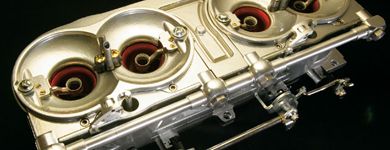
There have been amazing technological advancements with the automobile in the past several decades, many of which have found their way into street rods. And, while much of this advanced technology has obvious advantages, it can also bring with it a host of complications. It seems as though everything now needs a standalone computer, a bundle of wires the diameter of the Governator's forearm, and sensors everywhere but in the taillights; this holds particularly true when aftermarket fuel injection is the subject at hand.
While the benefits of electronic fuel injection are well known, the fact is there are some instances where the simplicity of a carburetor is a distinct advantage, namely when a high-performance camshaft is used. In most applications, computer-controlled fuel injection relies on a strong vacuum signal at idle to determine the proper amount of fuel to deliver. However, most long-duration, high-performance camshafts-the type with the lumpy idle most hot rodders love-result in a weak vacuum signal at idle. The computer interprets this as the engine being under a load and supplies more fuel to the injectors than is actually required. The result is poor low-speed performance and initial throttle response. On the other hand, a carburetor recognizes just one thing: the vacuum signal at the point fuel is discharged.
The speed of air increases when air flows through a venturi (a tube that gradually gets smaller in diameter then becomes larger again). Thanks to something called Bernoulli's law, air pressure decreases as air speed increases. The fuel-which is the other component in the combustible mixture necessary for the engine to run-is held in a separate chamber with a vent to let in atmospheric. Air passing through the venturi when the engine is running creates a low-pressure area while there is higher atmospheric in the float bowl. As a result, fuel passes through a passageway leading to the venturi and is introduced into the air steam. The throttle controls the amount of airflow, and the amount of airflow controls the amount of fuel pulled out of the float bowl. The air pressure in the venturi and the float bowl is equal when the engine shuts off, so fuel stops flowing. Of course, this is a pretty simplistic explanation of how carburetors work, and they have lots of subsystems that refine their operation, but the point is there isn't a capacitor or computer chip required to do the job; a carburetor responds to the engine's needs without them.
One of the standard comparisons made between fuel injection and carburetors has to do with mixture balance. Obviously, a fuel injector at every intake port is better able to provide an equal quantity of fuel to each cylinder than a carburetor plunked in the middle of eight cylinders. By virtue of the carburetor's location, the manifold runners not only have different lengths, but some have tighter bends than others. A solution to this dilemma is to use multiple carburetors and spread them out. But, sometimes the cure is worse than the disease; multiple carburetors often make tuning and maintenance more complicated. A more effective means of improving fuel distribution is to simply change the shape of the carburetor-something Ford discovered in the late '60s.
Ford developed the unique Autolite 4100 inline carburetor in an effort to cure fuel-distribution issues in its Can Am Mustangs. Although the idea was a good one, the execution left something to be desired, and the carburetor never really lived up to its potential. Still, its performance was good enough for the carburetor to be banned from SCCA competition in 1970 for giving Ford an unfair advantage.
When the R&D crew at Barry Grant's decided to rethink the carburetor, they had a lofty goal in mind: the even fuel distribution of EFI without the hassles of electronics. The fulfillment of that goal is the revolutionary BadMan induction system consisting of the all-new Demon Inline four-barrel carburetor and Triple-D Aero-ram intake manifold.
One of the things Grant's team discovered early on was the superior fuel distribution of the inline carburetor allowed big, long-duration camshafts to idle at lower engine speeds (as much as 400 rpm lower) when compared to a single four-barrel. Improved low-end throttle response and part-throttle drivability, along with better fuel mileage, were additional benefits.
Similar to a conventional four-barrel, the BadMan has two primary throttle valves and two mechanically operated secondaries that open as the carburetor approaches wide open. But, while the progressive operation of the throttle plates is standard, a noticeable departure from the norm is the lack of a choke. According to Grant's people, a choke isn't necessary due to the superior fuel distribution; besides, most of the cars these systems will find their way onto don't see much winter use. Still, it would be our guess that some feathering of the throttle might be required on cool days until the engine gets up to temperature.
Interchangeable venturi sleeves that allow airflow ratings ranging from 500 to more than 1,000 cfm are available to make it easy to select the correct size BadMan for any application. This feature virtually eliminates the problem of having a carburetor that is too big or too small and provides the option of making carburetion changes as additional engine modifications demand. Another factor that is bound to make the BadMan popular is the emphasis on simplicity-there are only three adjustments: two idle-mixture screws and one idle-speed screw.
Currently, the BadMan is available for small-block Chevys, with versions to fit big-blocks and LSI to follow. Two finishes are available: as-cast or silver powdercoat, and side covers will be offered in polished or ribbed finishes to match valve covers and air cleaner. And, although there is nothing official yet, don't be surprised to see Barry Grant offering the BadMan with optional components such as cylinder heads and camshafts.